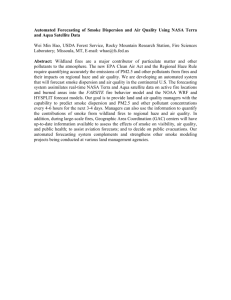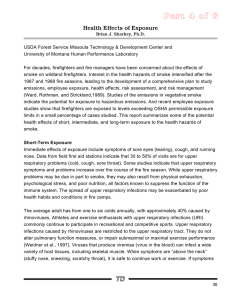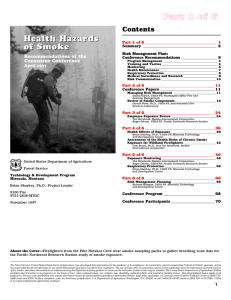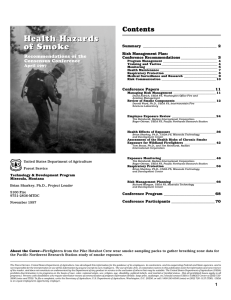Part 2 of 6 Conference Papers Managing Risk Management
advertisement
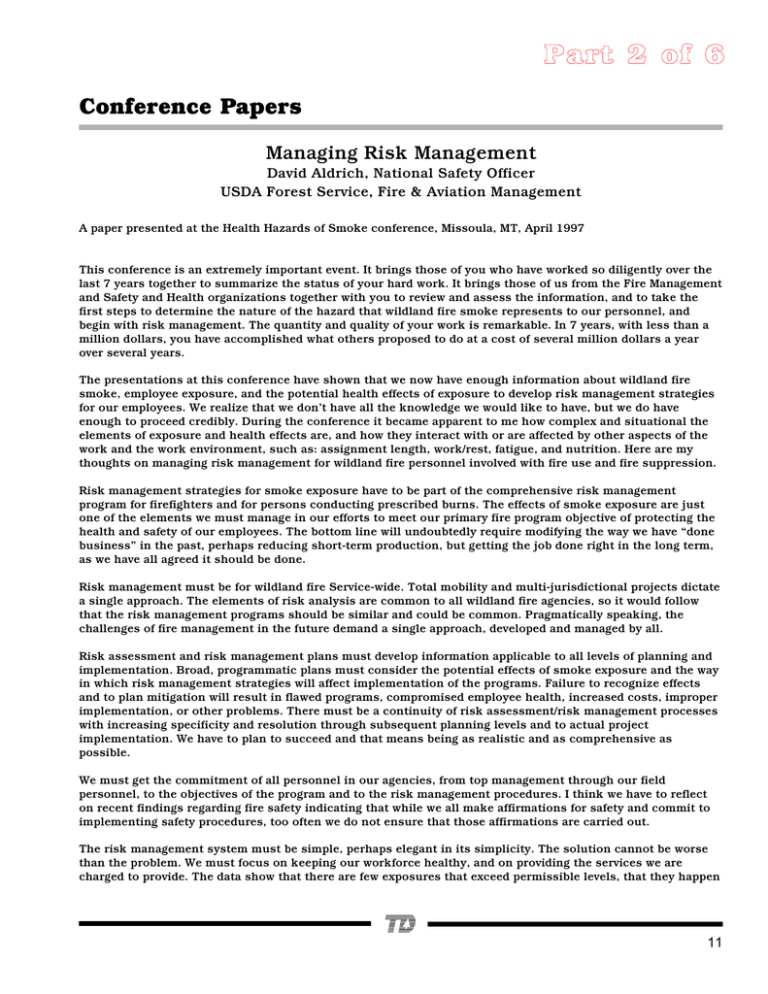
Part 2 of 6 Conference Papers Managing Risk Management David Aldrich, National Safety Officer USDA Forest Service, Fire & Aviation Management A paper presented at the Health Hazards of Smoke conference, Missoula, MT, April 1997 This conference is an extremely important event. It brings those of you who have worked so diligently over the last 7 years together to summarize the status of your hard work. It brings those of us from the Fire Management and Safety and Health organizations together with you to review and assess the information, and to take the first steps to determine the nature of the hazard that wildland fire smoke represents to our personnel, and begin with risk management. The quantity and quality of your work is remarkable. In 7 years, with less than a million dollars, you have accomplished what others proposed to do at a cost of several million dollars a year over several years. The presentations at this conference have shown that we now have enough information about wildland fire smoke, employee exposure, and the potential health effects of exposure to develop risk management strategies for our employees. We realize that we don’t have all the knowledge we would like to have, but we do have enough to proceed credibly. During the conference it became apparent to me how complex and situational the elements of exposure and health effects are, and how they interact with or are affected by other aspects of the work and the work environment, such as: assignment length, work/rest, fatigue, and nutrition. Here are my thoughts on managing risk management for wildland fire personnel involved with fire use and fire suppression. Risk management strategies for smoke exposure have to be part of the comprehensive risk management program for firefighters and for persons conducting prescribed burns. The effects of smoke exposure are just one of the elements we must manage in our efforts to meet our primary fire program objective of protecting the health and safety of our employees. The bottom line will undoubtedly require modifying the way we have “done business” in the past, perhaps reducing short-term production, but getting the job done right in the long term, as we have all agreed it should be done. Risk management must be for wildland fire Service-wide. Total mobility and multi-jurisdictional projects dictate a single approach. The elements of risk analysis are common to all wildland fire agencies, so it would follow that the risk management programs should be similar and could be common. Pragmatically speaking, the challenges of fire management in the future demand a single approach, developed and managed by all. Risk assessment and risk management plans must develop information applicable to all levels of planning and implementation. Broad, programmatic plans must consider the potential effects of smoke exposure and the way in which risk management strategies will affect implementation of the programs. Failure to recognize effects and to plan mitigation will result in flawed programs, compromised employee health, increased costs, improper implementation, or other problems. There must be a continuity of risk assessment/risk management processes with increasing specificity and resolution through subsequent planning levels and to actual project implementation. We have to plan to succeed and that means being as realistic and as comprehensive as possible. We must get the commitment of all personnel in our agencies, from top management through our field personnel, to the objectives of the program and to the risk management procedures. I think we have to reflect on recent findings regarding fire safety indicating that while we all make affirmations for safety and commit to implementing safety procedures, too often we do not ensure that those affirmations are carried out. The risk management system must be simple, perhaps elegant in its simplicity. The solution cannot be worse than the problem. We must focus on keeping our workforce healthy, and on providing the services we are charged to provide. The data show that there are few exposures that exceed permissible levels, that they happen 11 Part 2 of 6 under conditions that don’t surprise us, and that the effects on human health appear to be relatively small. Our approach to risk management should be to provide easily understood guides, proper training, and needed equipment, and to empower knowledgeable and committed people to take the appropriate actions to accomplish the objectives that have been identified. The job is not completed; it has really just begun. We are closing the book on the original work and starting the first implementation. The risk management system has to have a feedback loop for evaluation of the risk management measures, as well as to examine the effectiveness in terms of long-term risk management goals. We must be able to identify available knowledge or technology that can help, as well as be ready to identify and work to obtain additional knowledge or technology. The success of the original work in achieving the vision of participants in the San Diego meeting (Ward and Rothman, 1989) will depend on how well we implement the knowledge in hand, and how well we respond to needs for more or better knowledge in the future. Finally we need to recognize the National Wildfire Coordinating Group (NWCG) for having the vision and recognizing the need to work on the effects of smoke on firefighters, and for their funding of the project. Dick Mangan, Fire and Aviation Program Leader at the Missoula Technology and Development Center, and Dr. Brian Sharkey, coordinator of the Health Hazards of Smoke Project, deserve special thanks for their enthusiastic pursuit of this critical work, for effectively communicating information and findings, and for delivering, on time, the products of the project. We are in debt to each of the many scientists and technical people who have accomplished the research on a tight budget and in the face of many obstacles. The Health Hazards of Smoke Project has truly been field oriented, and it has provided the direction we need to accomplish the goal of this consensus conference, the development of a risk management program capable of being implemented within the existing fire management organization. References Ward, D., N. Rothman, and P. Strickland, The Effects of Forest Fire Smoke on Firefighters: A Comprehensive Study Plan, National Wildfire Coordinating Group, 1989. Review of Smoke Components Darold E. Ward, Ph.D. USDA FS, Intermountain Fire Sciences Laboratory 12 Part 2 of 6 13 Part 2 of 6 14 Part 2 of 6 15 Part 2 of 6 16 Part 2 of 6 17 Part 2 of 6 18 Part 2 of 6 19 Part 2 of 6 20 Table II (continued) Part 2 of 6 21 Part 2 of 6 22 Part 2 of 6 —End Part 2— 23


